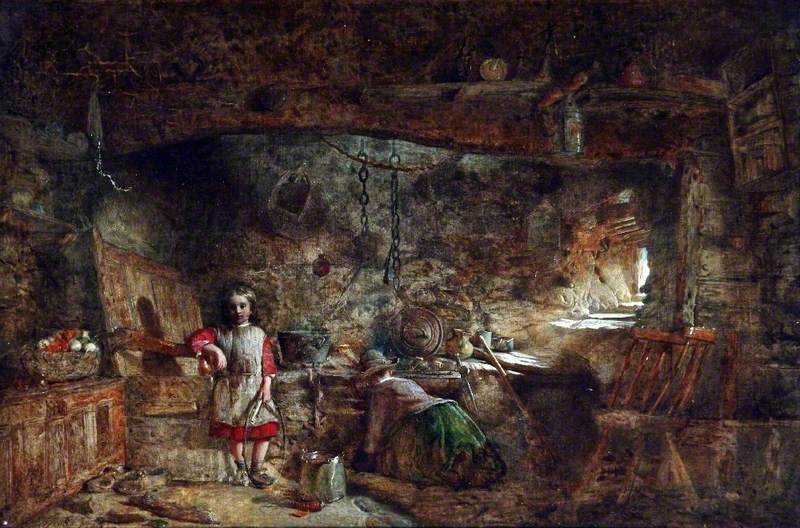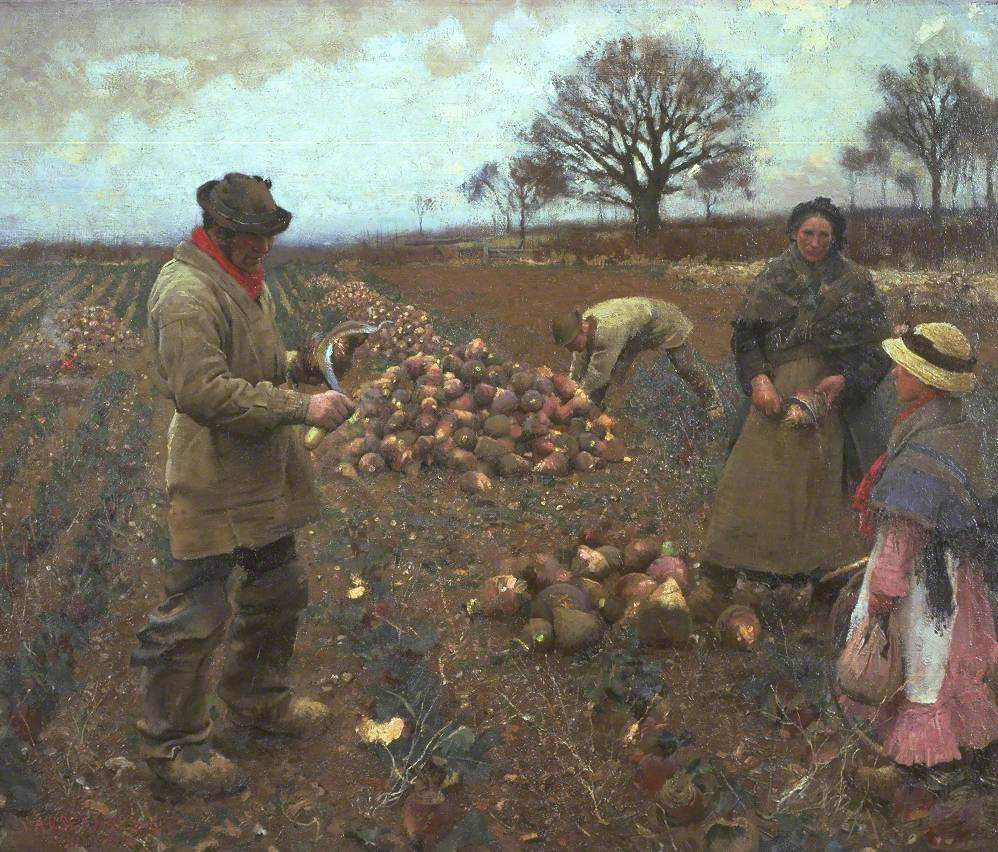Guest blog post
Here is the second part of the guest post by Helen Barton and Neil Bruce, MLitt students at the University of the Highlands and Islands, who have carried out research on gender and family in the Highlands using the Statistical Accounts.
_________________________________________
In part one, we considered what the Old Statistical Accounts told us about Highland Childhoods, focusing on Health and Disease, and Family Structures. In part two, we look at the Domestic Economy and Education.
Domestic Economy
Rural and town children were commonly brought up in homes where domestic work, employment and child-rearing were being juggled by female adults across generations. Accounts allude to the precariousness of bringing-in income. In many cases, both parents needed to earn to achieve sufficient income to sustain the family. When an Avoch fishing crew drowned, widows received charitable aid, but social expectation was that even those with young infants would soon return to industrious work (OSA, Vol. XV, 1795, pp. 634-5):
The distress of the widows having been thus mitigated, particularly until such of them had been left pregnant were delivered, and had nursed their infants, they have almost all now returned to the proper habits of industry, sufficient to support themselves and their families.
We can discern from the accounts typical levels of family income, and the cost of sustaining life, not just lifestyle. Families were experiencing increases in costs, noted to have doubled over four decades in Tarbat (OSA, Vol. VI, 1793, pp. 431-2). In the far North Highlands, it was estimated to be in the region of £14 per year (OSA, Vol. XIX, 1797, p.29). Children frequently worked for wages or boarded as farm labourers to make ends meet. Married men received a higher wage than single people, and men generally received higher wages. Income was gender, age and board-dependant. In Dingwall, there were limited wages for male labourers and families were highly dependent on supplementary income. This was usually from women spinning as “(T)here is no room for children to exert industry as there are no manufacturers. The whole income of the family can therefore not exceed L9:16”’ (OSA, Vol. III, 1792, p.13). This example of working mothers is repeated throughout the region. It points to waged work being introduced, and again, the need for two adult incomes to sustain families.
Elsewhere in Scotland, children were widely employed in manufacturing. They were cheap to employ before reaching at 14 years when higher wages were paid (C.A. Whatley, ‘The Experience of Work’, in T. M. Devine & R. Mitchison (eds) People and Society in Scotland, Vol 1, 1760-1830 (Edinburgh, 1999), pp. 239-46). There are frequent references to Highland children’s priorities being to the family; in Rogart, children worked as “servants”, for their parents, (OSA, Vol. III, 1792, p. 566) and on Barra they worked seed-planting and harvesting instead of attending school (OSA, Vol. XIII, 1794, p. 339). The contribution of children’s wages to the household was especially significant in areas where men were absent as women earned much less (OSA, Vol. I, 1791, p. 288).
However, most parish accounts make little direct reference to employment for children. It may be that in some parishes, children did not ordinarily work. More likely it was simply widely accepted they contributed to the family economy as another pair of hands, whether ‘wage-earning’, as domestic workers, or in farm work. It certainly seems common from the reports they were assumed to contribute to the overall household economy, though at what age is not always obvious.
Education
Initially there were no questions about schooling requested of parish ministers. A supplementary request to find out about “the state, organisation and size of the parish’s schools, number of scholars, subjects taught and how many went on to university” was made a year later (though sent out as Appendix C with a letter to clergy in 1791, the source quoted here is J. Sinclair, Specimens of Statistical Reports: Exhibiting the progress of political society, from the pastoral state, to that of luxury and refinement (London & Cornhill, 1793), p. XV).
As mentioned above, the economic value children contributed to the family unit meant education came second to work. their availability to attend school was determined by seasonal demands. Sir John himself subsequently assessed that “(T)he common people, in general, have little time for education.” (J. Sinclair, Analysis of the Statistical Account of Scotland: With a General View of the History of that Country, and Discussions on Some Important Branches of Political Economy (Edinburgh, 1831), p. 72). His statement was informed by the reports indicating poor school attendances, but did not note parental income levels, or the ease of access to schools.
While the local heritors (landowners) were legally required to ensure the provision of a school in each parish, in practice, that could depend on their residency or absence, willingness and ability to fund. It also depended on their preparedness for others, such as the Scottish Society for the Propagation of Christian Knowledge, to establish schools. The Scottish Society’s (SSPCK) Secretary, for example, identified “2 populous districts … where schools might be erected to great advantage”, were the proprietor to part-fund it (OSA, Vol. XIII, 1794, p. 315). Parish and other schools could and did charge for children to be taught; the quarterly fees in Stornoway, for example, included English and writing 2/6d; arithmetic and English 3/-; Latin, writing and arithmetic 4/- (OSA, Vol. XIX, 1797, p. 243).
The requirement was ‘a’ parish school – in Skye, the Outer Hebrides and Small Isles, a vast area of 2,000 square miles, and many inhabited islands, there were only 15 parishes, and unsurprisingly, the reports revealed the paucity of educational provision. Rev. John Macleod summed up the challenges of school provision and uptake on Harris: “the people of this country are so detached from each other” and the terrain, distances and paucity of good roads, meant, “there is really no fixing on a station in which any public institution can be of universal benefit” (OSA, Vol. X, 1794, p. 380).
What Sir John also did not acknowledge were reports of parents in more remote places making their own arrangements to have their children schooled. Equally, the accounts do not detail the age of those who attended school, or for how long; there is no reference to informal educational opportunities. As the reporters were usually the Kirk minister, there is often little information on the schooling of Roman Catholic children. Prunier has noted that Roman Catholics were debarred from teaching (C. Prunier, ‘‘They must have their children educated some way’: the education of Catholics in eighteenth-century Scotland’, Innes Review, Vol. 60, no. 1 (2009), p. 37).
Attendance at school in the west and north Highlands and Islands meant learning in English, not Gaelic, though for most, Gaelic was still their native tongue. This introduced children to another language, and in Barray, “numbers … who attended the school … (spoke) … English tolerably well” (OSA, Vol. XIII, 1794, p. 341). In contrast on the east coast, in Rosemarkie, Avoch, and Wick, for example, few, if anyone spoke Gaelic (OSA, Vol. XI, 1794, p. 348; Vol. XV, 1795, p. 632; Vol. X, 1794, p. 32).
The reporting of schooling was non-gendered, with either the subjects, or the number taking them listed. At North Uist’s parish school, “ten in general read Latin; the rest study geography, book-keeping, arithmetic, writing, and reading English” (OSA, Vol. XIII, 1794, p. 315), and at Strath, reading, writing, arithmetic and Latin were taught (OSA, Vol. XVI, 1795, p. 226). However, the reports do point to gendered-based opportunities for, and expectations on children – Sir John, himself argued, “society cannot be placed on an equal footing, unless the blessings of education are extended to both sexes”, though by that he obviously did not mean they both receive the same opportunities (J. Sinclair, Analysis of the Statistical Account, p. 126).
Sinclair himself penned the Thurso report and promoted the idea of an academy for boys once the Napoleonic Wars were over, lamenting there was no boarding school where girls could learn “needle-work, music and other subjects suited to the sex” (OSA, Vol. XX, 1798 p. 512). Elsewhere, girls were learning how to spin, for example, at SSPCK schools at Rowdill, and two spinning-schools in Barvas, jointly run with Mrs Mackenzie of Seaforth. At the latter, they were “taught gratis, have 10 pence for every spindle they spin, and to encourage them, they have their wheels at low rate; ” (OSA, Vol. X, 1794, p.269; Vol. XIX, 1797, pp.278–279). At Lochs, on Lewis, the minister opined that girls “secluded from the more cultivated part of society” could gain skills, industry and “real happiness” by learning to spin (OSA, Vol. XIX, 1797, pp. 278-279). In nearby Stornoway, two of the three SSPCK spinning schools were “laid aside for want of the requisite number of scholars”, the minister lamenting that previously “many poor girls have been rescued from habits of idleness and vice, and trained to industry and virtue” (OSA, Vol. XIX, 1797, pp. 243-244).
Stornoway’s parish had a broader, more obviously male-orientated curriculum, geared to future employment opportunities included navigation and book-keeping, and mensuration, the study of measurements (OSA, Vol. XIX, 1797, p. 243). The reports suggest only a few boys continued their education at university. Duirinish parish had four “students” at university in Aberdeen; North Uist’s parish school sent “one yearly to College”, and two, “who got the rudiments of their education” attended “University last winter” (OSA, Vol. IV, 1792, p. 133; OSA, Vol. XIII, 1794, p. 315).
Conclusion
there is much to be gleaned about what childhood meant for the many growing up in the later eighteenth century from the Far North and Outer Isles parishes accounts. Our examples do point to the limitations of the Accounts as the level of detail is inconsistent, anonymised and general, rather than specific.
We’ve only scratched the surface and there are other fruitful areas, for example:
- the family economy;
- inter-generational relationships;
- what it was like to be one of the elite;
- the extent of choice children had in their future.
And, perhaps, given that Sir John, set out to ascertain the “state of the country” in 1790, to “reveal the quantum of happiness in a population”, believing “every individual … shall have the means of enjoying as much real happiness as the imperfect condition of human nature will admit”, assessing how happy childhood was for the many (R. Mitchison, Sir John Sinclair, first baronet (1754 – 1835), Dictionary of National Biography, accessed 19th September 2017; J. Sinclair, Specimens of Statistical Reports, p. IX).
—oOo—
We would like to thank Helen and Neil for their fascinating guest blog post. We hope it inspires others to carry out their own research using the Statistical Accounts of Scotland. Indeed, if you would like to write a guest post on how you have used the Statistical Accounts in your study or work please let us know by emailing edina@ed.ac.uk!

